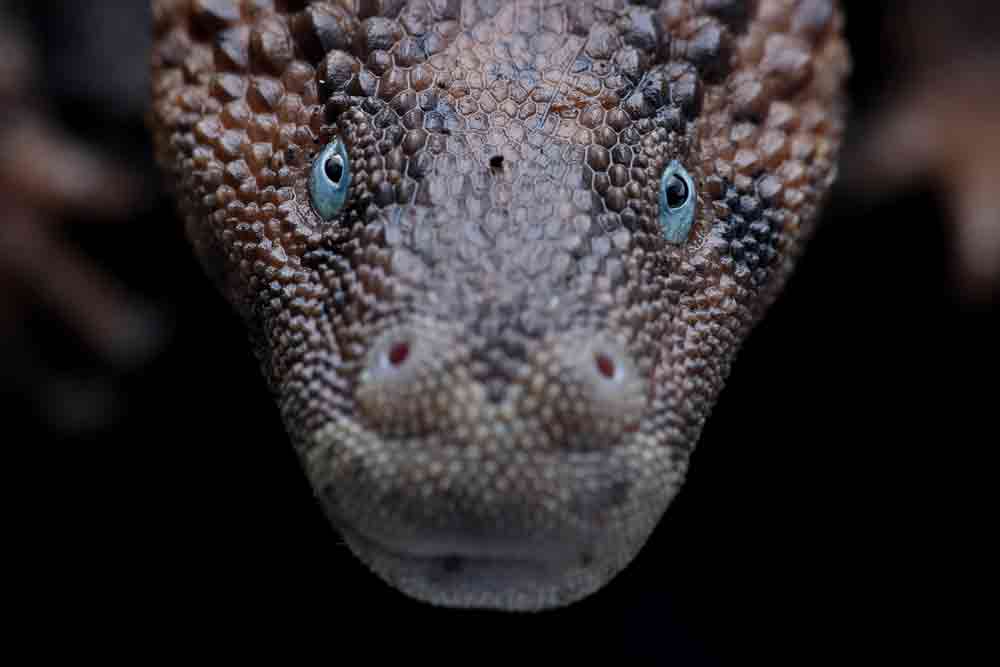As beautiful as a daydream. That would be the Borneo earless monitor (Lanthanotus borneensis). This semi-aquatic lizard was first recorded to be found
As beautiful as a daydream. That would be the Borneo earless monitor (Lanthanotus borneensis). This semi-aquatic lizard was first recorded to be found and collected in 1891 in its native habitat in the Rejang river in Sarawak, (Malaysian Borneo) by C.A. Bampfylde. [1] I’m looking at my computer screen and I see an orange brown cylindrical dragon with its prominent keeled scales. It has small black eyes and seems to be looking at me grinning as if ready to devour me. And then I realize I’m looking at a lizard that’s a mere 16 inches long.
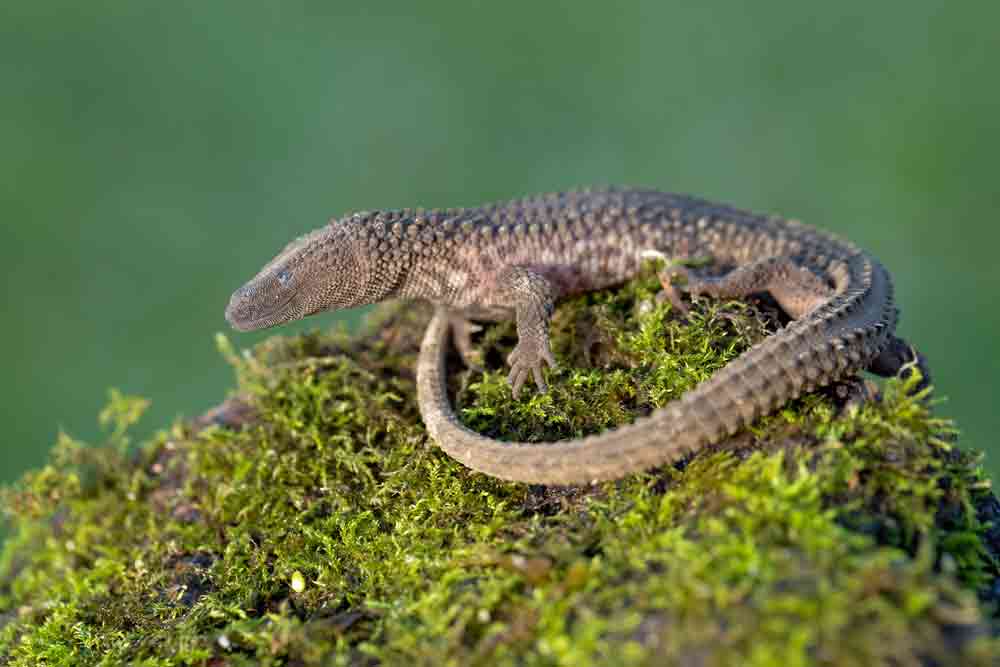
The Borneo earless monitor’s habitat has suffered from high deforestation rates in its native range of Indonesian Borneo and Malaysia. Photo by Milan Zygmunt/Shutterstock
The Borneo earless monitor has come a long way since it was first described and submitted to the Denkschriften der Kaiserlichen Akademie der Wissenschaften, Mathematisch-Naturwissenschaftliche Classe (Memoirs of the Imperial Academy of Sciences) in 1877 by Franz Steindachner, an Austrian zoologist and herpetologist who first saw the reptile in Sarawak..[1] Between 1877 and 1960, only 12 specimens of the reptile had been recorded. Protected by Malaysian law and two neighboring countries Brunei and Indonesia, Lanthanotus borneensis had been relatively unknown to the outside world. [2]
Herp Queries With Bill Love: The Earless Monitor
5 Earless Monitor Lizards Hatched At Prague Zoo
However in 2006 and 2008 , Lanthanotus borneensis was recorded to be found in West Kalimantan (Indonesian Borneo). And in 2012, a paper was published describing the 2008 discovery of L. borneensis in Jelimpo, W. Kalimantan, its microhabitat structure, and its local distribution. The purpose of the paper was to establish the presence of L. borneensis in W. Kalimantan (Indonesian Borneo) and to inform the general public how high deforestation rates in Borneo has raised concern over L. borneensis population fragmentation and viability.
In reverse, the paper piqued the interest of international reptile collectors and became a goldmine of information for unscrupulous traders. Thus, Indonesia’s West Kalimantan became a destination of clandestine collection expeditions. Despite Malaysian, Brunei Darussalam and Indonesian laws in 1971, 1978 and 1980 prohibiting the trade of L. borneensis and imposing penalties of up to USD$8,600, published journal(s) and social media created an overwhelming interest in the reptile. The emerging illegal trade during the previous decade catapulted the Borneo earless monitor to reptile fame and earned it the title, ‘the Holy Grail of herpetology.’ [3] [2]
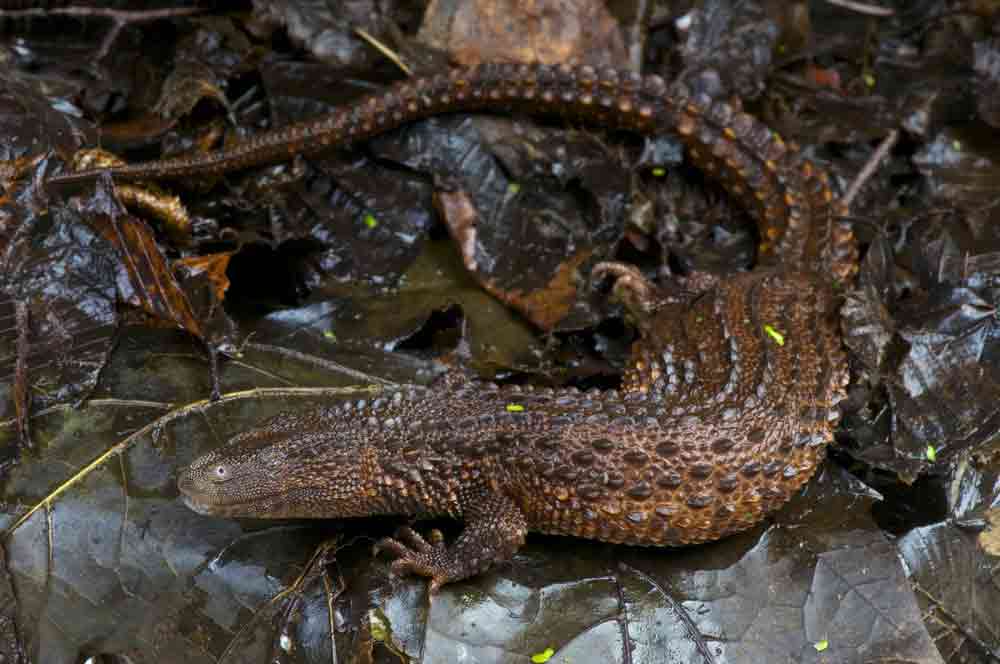
The first published record of Lanthonotus borneensis in West Kilamantan occurred in September 2012. Photo by Reptiles4all/Shutterstock
The Malaysian government in 2015 submitted a nine page proposal to the Convention of International Trade in Endangered Species of Wild Fauna and Flora (CITES) to list L. borneensis in the CITES Appendix I.[4] But as of CITES Apendix I, II, and III valid from 22 June 2022, Lanthanotidae borneensis is listed under Appendix II with the following information Lanthanitidae spp. (Zero export quota for wild specimens for commercial purposes). [5]
In 2021, the International Union for Conservation of Nature and Natural Resources (IUCN) listed Lanthanotus borneensis Steindachner, 1878 under the category EN (Endangered). In its assessment, the IUCN stated there has only been about 150 L. borneensis specimens collected in 150 years and less than 15 localities confirmed and presumed lost due to deforestation. The surviving population is ‘considered’ to be severely fragmented. [6]
In December 2016, Prague Zoo released a news item announcing the arrival of seven “earless monitor lizards” from Japan. According to the article, the reptiles are descended from the first captive breeding in 2014 by Tsuyoshi Shirawa, Director of iZoo in Japan’s Shizouka Prefecture. IZoo is the first zoo to successfully hatch captive bred L. borneensis. This occurred in December 2014. But some have questioned the origin of Izoo’s original breeding pair because the governments of Malaysia, Indonesia and Brunei Darussalam claim to have no report of any legal export of the species.
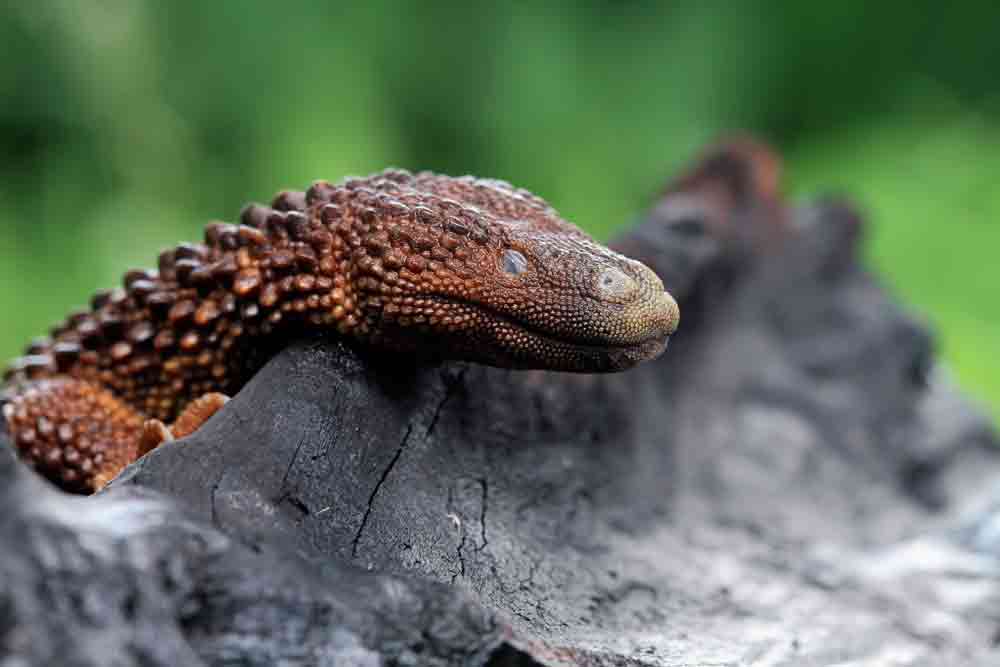
Between 1877 and 1961, only 12 Lanthanotus specimens were recorded, all which were found in Lower Sarawak. Photo by Kurit Afshen/Shutterstock
The specimens in Prague Zoo consisted of one (1) female adult and 6 hatchlings. The news item also stated that Prague Zoo’s goal is ‘to actively participate in the development of a European breeding program for the species in order to establish a sustainable population in captivity.’ [7]
The zoo’s first successes after it acquired the reptiles occurred in 2018, with a successful breeding that resulted in the hatching of five monitor lizards. The most recent successes occurred in October 2022, with the hatching of seven earless monitors.
“Eggs approximately 3 x 2 cm in size and weighing 4.7–5.0 g were laid by the female on 21 July, 2022. The first lizard hatched on October 19, now there are seven of them in total and they are already starting to eat. If all the monitor lizards are fine, we will reach a total of 31 reared earless monitors since 2018,” Alena Maderova of the Prague Zoo told REPTILES. “Small monitor lizards will significantly contribute to the further life of the breeding,” Maderova said.
“In the past, we have transported these captive bred lizards to many zoos, for example in Zagreb, Berlin, Cologne, Pilsen, New Orleans or the French Beauval Zoo. Their mother came to us from the Japanese iZoo in 2016 as a newly hatched baby. The father is a newly represented male who lived in Austria for a long time and was imported to the Prague Zoo in 2021. Visitors can see adult monitor lizards in the night exhibition of the Indonesian Jungle pavilion. The young ones are raised in the breeding facility.”
Between 2019 and 2021, Prague Zoo has transferred earless monitor lizards to Zoo Parc de Beauval(France), Cologne Zoo (Germany), and Audubon Zoo in the United States. [8]
Sixteen zoos in Asia, Europe, and the United States are known to keep L. borneensis. Some of these zoos have successfully bred the earless monitor lizard. These reptiles have not been exported from the species’ range countries and there is no evidence to suggest they were illegally imported or traded. However a report has accused these zoos of consenting to illegal wildlife trade as was written in the paper’s title. Does captive breeding of a species that is protected in their range countries where there are only less than 15 confirmed local individuals justify the program? The acquisition and captive breeding of the earless monitor lizard by the zoos in Europe have affected the price of the reptiles in the European market from €8,167 per individual in 2014 to €900 in 2020. With the prices in great decline, does it mean that L.borneensis loses its appeal to sophisticated reptile collectors? Will L. borneensis lose its title as, the ‘Holy Grail of herpetoculture?’ Will captive breeding finally put to an end to the illegal trade of the earless monitor lizard in their range countries? [8]
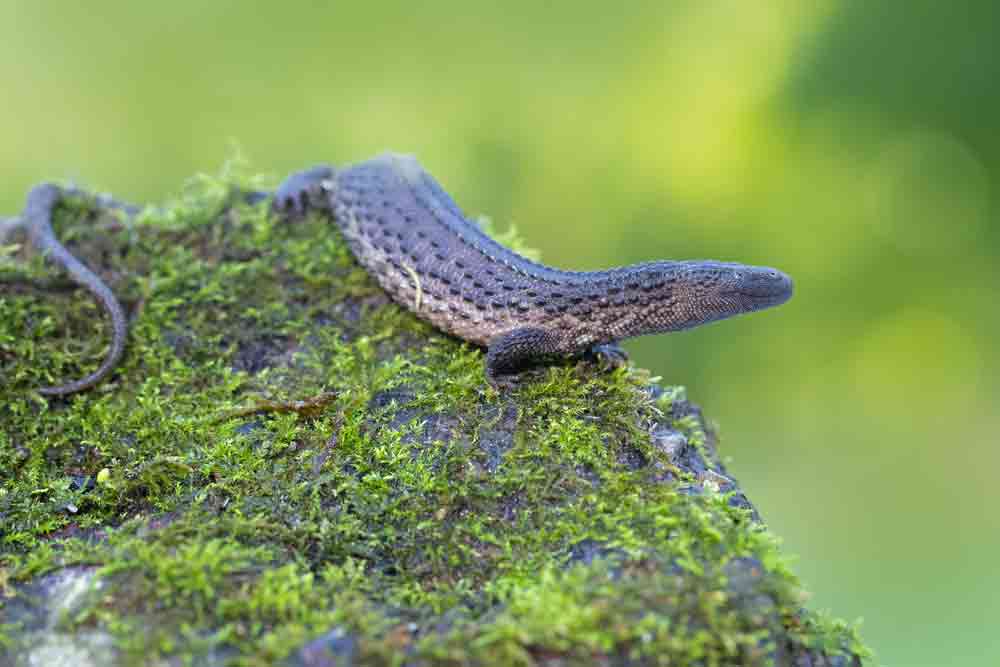
In March 2017, Schonbrunn Zoo became the second zoo in the world to successfully breed the lizards. Built in 1752, it is the oldest operating Zoo in the world and has been named the best zoo in Europe five times. Photo by Milan Zygmunt/Shutterstock
Only time will tell, but it is notable that Colombia turned to captive breeding of the golden poison frog (Phyllobates terribilis) in an effort to end the illegal trade of the amphibian, and as a result of Colombia’s efforts, the illegal market for wild-caught golden poison frogs collapsed as the previous $150 price tag per wild-caught frog dropped to $35 for the captive-bred frogs.
A Battle of Family Names
The Borneo earless monitor (Lanthanotus borneensis Steindachner 1878) was first described and submitted to the Denkschriften der Kaiserlichen Akademie der Wissenschaften, Mathematisch-Naturwissenschaftliche Classe (Memoirs of the Imperial Academy of Sciences) in 1877 by Franz Steindachner. Steindachner described L.borneensis to be 16.5 inches long (42 cm) of which 8.6 inches (22 cm) belong to the tail. Although he submitted his abstract in 1877, the Denkschriften was not published until 1878, hence the scientific name Lanthanotus borneensis Steindachner 1878.
Steindachner created a new family called Lanthanotidae, making L. borneensis the only species in its family. Initially, he thought the reptile was related to the gila monster (Heloderma suspectum) however found the lack of ears peculiar. He also found the scales of the back to be similar to certain crocodiles, which he also found to be substantially different from that of the gila monster. He also described the posterior teeth as furrowed like Heloderma. Steindachner did not describe the habitat of the individual specimen, only that it was brought by a Mr Gröger from Sarawak. [1]
In 1884 Belgian-British zoologist George Boulenger intimated that Lanthanotus would soon join the family Helodermatidae. Having no access to a Lanthanotus specimen, he condensed Steindachner’s description in a catalog and placed the genus under Helodermatidae with zero explanation. In 1899, Boulenger, through a male specimen loaned from Sarawak Rajah James Brooke, was able to conduct a close examination of the earless monitor. The specimen was said to be found in 1891 in Rajang River in Sarawak by a C.A. Bampfylde. Boulenger wrote a description of the lizard’s mouth and drew a diagram of the widely-opened mouth describing the grooved teeth and presumed that the earless monitor is venomous like the gila monster and affirmed his argument that Lanthonotus should be contained in the family Helodermatidae. [1]
The Americans
In 1954, American herpetologists Samuel B. McDowell and Charles M. Bogert were the first to use the name ‘earless monitor’ in their article in the Bulletin of the American Museum of Natural History. Bogert and McDowell conducted a thorough review of the Lanthanotus, and returned the lizard to its original family Lanthanotidae. They summarized that Lanthanotus appeared to be distantly related to Heloderma, with its resemblances to the genus being either convergent or generalized platynotan (of the clade Platynota (gila monsters, Komodo dragons, monitor lizards) characteristics. Bogert and McDowell stressed dissimilarities between Lanthanotus and various lizards that have been suggested as close relatives of the Bornean form. They stressed that the Lanthanotus and Varabus are on ‘firmer footing’ due to a large number of positive resemblances and that the great number of detailed resemblances makes it difficult to doubt that they are closely related. [1] [9]
Sarawak
The Lanthanotus specimen that was studied and described by George Boulenger in 1899 was collected in 1891 by C.A. Bampfylde in the Rejang River. It was one of two specimens that were lent to Boulenger by Raja Brooke (Raja James Brooke) of Sarawak. We can presume that C.A. Bampfylde is Charles Agar Bampfylde, author of the book “A History of Sarawak Under Its Two White Rajahs 1839-1908.” In his book, Bamfylde mentioned three types of reptiles; the crocodiles, snakes including pythons, and flying lizards. He mentioned the Rejang River. The book did not account his finding the Lanthanotus in the Rejang River. In the early 1960s Tom Harrison and his wife Barbara published works on their attempted husbandry of the Lanthanotus. Barbara kept detailed notes on the lizard’s behavior, preferred food, temperature, soil and water. Barbara Harrison’s work is the first published report of Lanthanotus in captivity. [1] [10] Between 1877 and 1961, only 12 Lanthanotus specimens were recorded, all which were found in Lower Sarawak. [1]
West Kalimantan
In 2006 and 2008, Lanthanotus borneensis was recorded to be found in West Kalimantan (Indonesian Borneo). In May 2008, an individual specimen of L. borneensis was found under leaf litter in a shallow rocky creek by a member of a team commissioned by an oil company to conduct surveys in proposed oil palm estates. Surveys were conducted to minimize biodiversity, environmental, and social impacts. The L. borneensis specimen was discovered in a community fruit garden also known as tembawang which is part of the oil palm estate in Jelimpo, Landak, West Kalimantan (Indonesian Borneo.) The estate where the lizard was found and its surroundings are comprised of swidden agricultural fields, rubber plantations, and secondary forests. In August 2008, the survey team who discovered the lizard came back to the estate where they found the specimen to conduct the second phase of their survey. The team would conduct interviews with community members who frequented forests in the proposed estates. They would present a photo album of flora and fauna used as a visual aide to help the participants identify which among these species still occur in the area. At that time, the team added L. borneensis in the album and conducted the community interviews in the estate where they found the lizard earlier that year and three other proposed estates. A majority of the survey participants in all four responded that the lizard was present in their area. [3]
Holy Grail Effect
On September 2012, B. Yaap, et al. published the first record of Lanthonotus borneensis found in West Kilamantan. The paper described in detail the May 2008 discovery of the L.borneensis by the survey team in Landak and its microhabitat. It also showed results of the community survey with a majority of the participants confirming that the lizard was present in all four participating proposed estates. Although the survey included the GPS coordinates of the location of the recorded discovery, the authors retained the data to avoid misuse by illegal traders. But the data provided therein did not need GPS coordinates in order for the illegal traders not to track the location of the recorded discovery. [11]
There was so much talk about the earless monitor lizard on the internet it became an international reptile sensation. Dragon-like lizard from Borneo. Very rare species. Protected by the government of Malaysia, Brunei Darussalam, and Indonesia.
This constant promotion of the earless monitor lizard’s reputation as “Holy Grail of Herpetology” fueled so much interest among unscrupulous reptile collectors some were willing to pay the expensive price for exclusivity. The export of L.borneensis from its range countries of Malaysia, Brunei Darussalam and Indonesia is prohibited and punishable by imprisonment and a fine of up to USD$8600.
iZoo
In December 2014, iZoo in Shizuoka, Japan publicly announced the first captive-bred earless monitor lizards to produce hatchlings. The zoo confirmed the first mating of the lizards in June 2014 and photos were shown on their Facebook page. In July 10, 2014, it was confirmed that L.borneensis is oviparous. According to the hobby site Aquaturtlium, the July clutch turned out unsuccessful as the juveniles died when they hatched in September 2014. This information, according to the site was deleted from iZoo’s Facebook page. On December 7, 2014 the zoo announced the first successful captive breeding of Lanthanotus borneensis in the world.
Now in its 9th year of successfully breeding Miminashio lizards (as they are called in Japan), it has not been an easy journey for iZoo and its owner Tsuyoshi Shirawa. Mr. Shirawa, president of Japan Reptile And Amphibian Society since 2016, has been the subject of numerous criticisms since the arrival of L. borneensis at the zoo in April 2013. The origin of the initial breeding pair was in question, “since neither Indonesia or Malaysia has ever reported the legal export of earless monitor lizards.” [12] [13] [14] [15]
If iZoo has two clutches of L.borneensis in a year by separate breeding pairs with a minimum of six eggs per clutch and granting that all the eggs hatched successfully, multiplied by nine years, iZoo would have produced 108 captive-bred earless monitor lizards. iZoo would then need only 42 hatchlings to equal the 150 L.borneensis specimens found in more than 150 years, per IUCN’s October 2019 assessment information.
In March 2017, Schonbrunn Zoo became the second zoo in the world to successfully breed the lizards. Built in 1752, it is the oldest operating zoo in the world and has been named the best zoo in Europe five times. Schonbrunn Zoo is credited for saving Austria’s Ural owls from extinction, restoring a totally extinct in the wild vulture species, and being responsible for the birth of the elephant Kibali through artificial insemination, one of the first in Europe. [8] [16]
As for the other zoos, they either acquired their L.borneensis specimen from private individuals, from other zoos, or from seizures of animals that have been smuggled into the zoo’s country of location from countries that are outside the earless monitor lizard’s geographic range. Some of these zoos have successfully bred the earless monitor lizard. [8]
The European Association of Zoos and Aquariums (EAZA) has an 11-page list of its EX situ programs following the One Plan Approach (OPA) to species conservation. EAZA Taxon Advisory Groups (TAG) through a 5-Step decision making process in accordance with IUCN guidelines decides which species are recommended to be managed under an EAZA Ex situ Program (EEP). The 16 zoos are either accredited by WAZA or EAZA. And the earless monitor is not in EAZA’s Ex situ programme list. [17]
With 1800 kilometers of prime forest lost annually in Borneo, the remaining flora and fauna are threatened by further deforestation brought by palm oil, rubber plantations and commercial logging. The governments of the range countries will need a concrete conservation plan in restoring the ecosystem and bring back the earless monitor lizards and all other endangered species into Borneo’s lowland forests. This can only be achieved if they halt clearing what is left of the prime forests, conduct reforestation, and educate and engage community members in the conservation process. Indonesia is the world’s top palm oil producer with 2021 production amounting to 46.2 million metric tons. Malaysia accounts for 34.3 % of the world’s palm oil production. [5] [6] [18] [19] [20]
As of June 22, 2022, Lanthanotidae borneensis is listed under CITES Appendix II with the following information Lanthanitidae spp. (Zero export quota for wild specimens for commercial purposes). A report claims that the lizards acquired by the zoos were apparently at one point illegally exported out of the range countries, and/or direct offsprings of illegally traded individuals.
We must take into account that zoos, including those who acquired and/or bred the earless monitor lizards are experts in imitating natural habitats in terrarium settings. They may even have outdone the tembawang where the lizard was initially found in West Kalamintan. There is no clear picture as to what happens next when L.borneensis grows in impressive numbers. Will there be a reintroduction to Borneo? Or will they create a new destination for L.borneensis when the forests are gone? One thing is true. The zoos have produced hatchlings of a species that are rare to find even in its natural habitat in the Borneo lowlands. When private individuals finally are able to easily acquire a pair of earless monitor lizards, the quest for the “Holy Grail of Herpetology” will no longer be so appealing.
Works Cited
[1] R. Sprackland, “An Annotated Bibliography of the Bornean Earless Monitor, Lanthanotus Borneensis Steindahcner 1877,” Smithsonial Herpetelogical Information Service No.157.
[2] V. N. a. S. S. Stoner, “Keeping an ear to the ground: Monitoring the trade in earless monitor lizards,” 2014.
[3] M. &. Y. B. &. P. G. &. A. A. &. W. P. &. W. D. (. F. r. o. t. B. E. M. L. b. (. 1. (. i. W. K. (. B. J. Auliya, “First record of the Borneo Earless Monitor Lanthanotus borneensis (Steindachner, 1877),” Journal of Threatened Taxa.
[4] M. Government, “PROPOSAL TO LIST LANTHANOTUS BORNEENSIS IN APPENDIX I IN MALAYSIA,” 2015.
[5] “Appendices I, II and III valid from 22 June 2022,” 2022. [Online]. Available: https://cites.org/sites/default/files/eng/app/2022/E-Appendices-2022-06-22.pdf.
[6] I. Das and M. Auliya, “Lanthanotus borneensis. The IUCN Red List of Threatened Species.2021,” September 2021.
[7] “Prague Zoo,” 20 December 2016. [Online]. Available: https://www.zoopraha.cz/en/about-zoo/news/10400-prague-zoo-presents-the-holy-grail-of-herpetologists.
[8] V. Nijman, “Zoos Consenting to the Illegal Wildlife Trade- The Earless Monitor Lizard as a Case Study,” Nature Conservation, 26 February 2021.
[9] S. B. McDowell and C. M. Bogert, “The systematic position of Lanthanotus and the affinities of the anguinomorphan lizards.,” Bulletin of the American Museum of Natural History, vol. http://hdl.handle.net/2246/1146, 1952.
[10] C. (. A. Blamfylde, A History of Sarawak under Its Two White Rajahs 1839-1908..
[11] V. Nijman and S. Stoner, “Keeping an Ear to the Ground: Monitoring the Trade of Earless Monitor Lizards,” 2014.
[12] K-Ki, “Aquaturtlium,” 11 12 2014. [Online]. Available: https://aquaturtlium.com/izoo-succeed-breeding-of-earless-monitor-lizard/. [Accessed 2022].
[13] “iZoo Facebook Page,” 10 July 2014. [Online]. Available: https://www.facebook.com/reptiles.zoo.izoo/posts/736994383030253.
[14] “iZoo Facebook Page,” [Online]. Available: https://www.facebook.com/reptiles.zoo.izoo/posts/747034078692950.
[15] “iZoo Facebook Page,” 6 12 2014. [Online]. Available: https://www.facebook.com/reptiles.zoo.izoo/posts/829113613818329.
[16] “Best Guide to Schonbrunn Zoo,” [Online]. Available: https://ctdots.eu/places/austria/schonbrunn-zoo-guide/.
[17] “European Association of Zoos and Aquariums,” [Online]. Available: https://www.eaza.net/assets/Uploads/CCC/Other/November2022.pdf.
[18] E. Wikramanayake, “OneEarth Borneo Lowland Rainforests,” [Online]. Available: https://www.oneearth.org/ecoregions/borneo-lowland-rainforests/.
[19] “STATISTA.COM Production volume of palm oil in Indonesia from 2012 to 2021,” [Online]. Available: https://www.statista.com/statistics/706786/production-of-palm-oil-in-indonesia/.
[20] “MPOC.ORG.MY The Oil Palm ion Malaysia,” [Online]. Available: https://mpoc.org.my/about-palm-oil/#:~:text=Palm%20oil%20has%20also%20elevated,oil%20production%20and%20export%3B%20respectively..
[21] R. Nuwer, “Newsweek.Com The Black Market Trade for Endangered Animals Flourishes on the Web,” [Online]. Available: https://www.newsweek.com/2014/11/07/extinctcom-280884.html.
B.P. Ross is a writer based in Southeast Asia.

